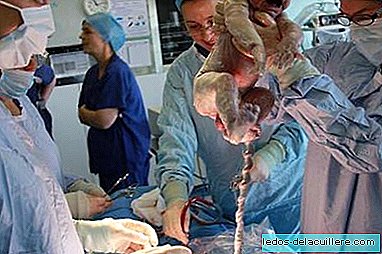
During pregnancy, the uterus is the body of the woman that grows the most, going from about 6 centimeters to more than 30 and weighing about 60 grams to one kilo. Like is logic, when the woman gives birth, the uterus gradually returns to its previous size, a phenomenon that is known as the process of uterine involution.
Thanks to this, through the postpartum contractions or contractions and by virtue of a series of hormonal changes, the uterus decreases in size and the blood vessels are sealed. But, sometimes, this involution does not occur and occurs a phenomenon not very frequent but that can become serious in the postpartum, called atony, hypotonia or uterine inertia.
Uterine atony is the obstetric term that refers to the loss of tone of the musculature of the uterus that results in a delay in the involution of the uterus. That is, the uterus does not "react" with contractions after the baby has been born and the placenta has been expelled.
Thanks to this contraction, bleeding is minimal in the mother: contractions of the myometrium compress the torn blood vessels during childbirth, reducing blood flow in the uterine wall. Therefore, if it disappears and we have a case of uterine inertia, severe vaginal bleeding occurs.
Hemorrhage is the first result of uterine atony, with the presence of hematoma on the upper lips and the accumulation of internal clots produces intense pain. This stoppage of the process of uterine involution due to atony can occur in up to 5% of natural births. Clinically, between 75 and 80% of postpartum hemorrhages are due to this cause.
Causes of postpartum uterine atony
The main causes of uterine atony or factors that trigger that loss of uterine tone can be:
- Uterine fatigue due to very long and active labor or dystocia (when the birth proceeds abnormally or difficultly).
- Precipitous delivery
- Placenta previa (when the placenta is implanted over the internal cervical orifice, in the lower part of the uterus, completely or partially covering the cervix).
- Uterine overstress due to multiple pregnancy.
- Very severe contractions that do not stop before the baby is born.
- Excessive abdominal distention due to very large babies (fetal macrosomia).
- Abundant amniotic fluid.
- Having had several previous pregnancies (multiparity).
- Retention of a rest of the placenta inside the uterus or infection.
- Previous caesarean sections
- Gynecological uterine surgeries.
- Excessive use of oxytocics during labor.
- Use of magnesium sulfate or general anesthetics.
Some risk factors For a complication to occur such as uterine atony are blood clotting problems, platelet deficiency in the patient, kidney failure, anemia, fibroids and diabetes.
On the other hand, according to the World Health Organization uterine atony-hypotonia is more frequent in caesarean sections than in vaginal deliveries.

What to do before uterine hypotonia
In case of uterine atony, the medical team will act according to the degree of incidence of bleeding. The first maneuver is usually the bimanual massage or compression of the uterus, with one vaginal intrusive hand and the other outside. The administration of drugs (such as oxytocin) may be necessary to stop bleeding. If the oxytocytes applied during the course of the atony do not resolve it, it is necessary to go to surgery.
In severe cases of uterine inertia, surgery with the ligation of the uterine arteries would be required and as an extreme case of maximum severity, the uterus (hysterectomy) would be removed. Uterine atony in the course of a C-section also requires surgical techniques.
Severe bleeding could cause the mother to lose consciousness due to hypovolemic shock or hemorrhagic shock, cardiac or respiratory arrest and a high risk of death.
Perinatal deaths from uterine atony they are frequent throughout the world, mainly in developing countries where adequate medical assistance is not widespread. According to WHO protocols, if it is detected that a woman after giving birth does not have the "security balloon" of Pinard (the contraction of the uterus for the sealing of blood vessels) specialized hospital assistance is needed.
Definitely, if there are no contractions or afterbirth in the postpartum we have a case of atony or uterine hypotonia, which leads to dangerous bleeding and needs urgent medical assistance. For proper recovery, the uterus has to gradually decrease in size after delivery, closing the open blood vessels and if the uterine muscles fail, this does not happen.
Photos | remysharp on Flickr and Thinkstock
In Babies and more | Immediate postpartum risks: inversion of the uterus, postpartum contractions or contractions












